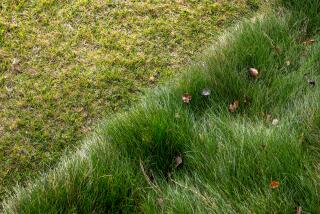Fighting Off the Invasion
- Share via
Question: How do I eliminate the large patches of crab grass that are invading my lawn?
D.G., Tustin.
Answer: December is a good time to start planning your strategy against crab grass. This grass can be a major weed pest in lawns. It is a low-bunching, leafy grass that comes in two forms. Large or hairy crab grass has large, hairy leaves that are green to yellowish green. Smooth crab grass, which is the most likely type to be found in residential lawns, is similar, except the leaves are smooth and longer and narrower.
Though crab grass is an annual, in warm weather climates such as ours, it can over-winter and create seed, which will cause it to spread. Seed germination begins in mid-January, so that is a good time to eliminate germinating weed seeds from your lawn to prevent further problems.
Other good crab grass controls:
* Increase the vigor of your turf grass by mowing your lawn at the proper height for your turf grass species. Mowing turf too low weakens it, allowing invasion by weeds such as crab grass.
* Be sure to thoroughly rinse off any seeds that may have gathered on your mower so that you don’t spread the crab grass to other parts of your lawn.
* Fertilize your lawn when it is actively growing. A vigorous lawn will make it difficult for crab grass to become established.
* Proper irrigation is key. Frequent light waterings make your lawn weak and susceptible to weed invasion. Over-watering favors crab grass development. Water your lawn infrequently but deeply.
* Hand-weed crab grass, making sure to seal any crab grass with seeds in a plastic bag to prevent spreading.
* There are pre-emergent herbicides that are applied before the crab grass seeds germinate. These will stop it from coming up, but they must be applied every year, since crab grass seed can remain viable in the soil for at least three years.
You can also use post-emergent herbicides that are applied when the crab grass is small.
To select the proper herbicide, consult with a certified nursery professional.
For more information on crab grass, take a look at the University of California pest note on crab grass at https://www.ipm.ucdavis.edu. At the UC IPM home page, select “Pests of Home and Landscape.” Then select “crabgrass” under the heading Weeds and Unwanted Plants.
Have a problem in your yard? University of California Cooperative Extension (UCCE) Master Gardeners are here to help. These trained and certified horticultural volunteers are involved with a variety of outreach programs, including the UCCE Master Garden hotline. You can reach the hotline at (714) 708-1646 or send e-mail to ucmastergardeners @yahoo.com. Calls and e-mail are picked up daily and are generally returned within two to three days.
HELP LINES
University of California Master Gardener Horticultural Hotline. Calls about horticulture and home gardening problems are answered by those who have completed an 18-week training program. (714) 708-1646. See Help Line column, this page.
Fullerton Arboretum Horticultural Help Line. Orange County Master Gardeners research your questions. (714) 278-4005.






